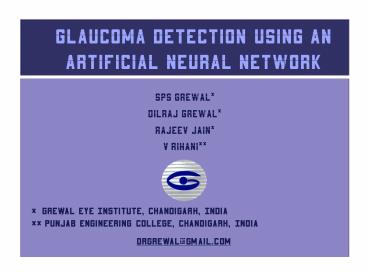Glaucoma Detection Using An Artificial Neural Network - PowerPoint PPT Presentation
1 / 6
Title:
Glaucoma Detection Using An Artificial Neural Network
Description:
However the sensitivity and specificity of any single diagnostic test is not ... scanning laser ophthalmoscope, and Stratus OCT optical coherence tomography for ... – PowerPoint PPT presentation
Number of Views:1254
Avg rating:3.0/5.0
Title: Glaucoma Detection Using An Artificial Neural Network
1
Glaucoma Detection Using An Artificial Neural
Network
- SPS Grewal
- Dilraj Grewal
- Rajeev Jain
- V Rihani
Grewal Eye Institute, Chandigarh, India
Punjab Engineering College, Chandigarh, India
drgrewal_at_gmail.com
2
Introduction
Glaucoma A Diagnostic Dilemma
- There are a number of tools available for
glaucoma with different diagnostic approaches.
However the sensitivity and specificity of any
single diagnostic test is not adequate to be
considered the gold standard. Combining the
information generated from different instruments
can theoretically have better diagnostic
capability. - Methods of early detection of glaucoma often
focus on Optic Disc Topography and RNFL
thickness, besides IOP to identify patients
likely to develop visual field defects. - In an attempt to classify the eye as normal or
glaucomatous, analysis strategies involve
analysis of input parameters from different
instruments using linear discriminant function
(LDF) or Artificial neural networks (ANN) or an
experienced Glaucoma specialist. - We aim to classify the eyes as normal or
glaucomatous based on input parameters from
different instruments using an Artificial Neural
Network. Multilayer perceptrons (MLP) with back
propagated learning were used.
3
Methods
Artificial Neural Network
- A Multilayer Perceptron model (MLP) with back
propagated learning method based Artificial
Neural Network (ANN) for glaucoma detection was
trained and tested using EasyNN-plus (v6.0g)
software simulator. - The modeled ANN had 114 input nodes corresponding
to each parameter from the tests conducted
Perimetry (Octopus 1-2-3), RNFL analysis on
Scanning Laser Polarimetry (GDx Nerve Fibre Layer
Analyzer Carl Zeiss Meditec, Inc., Dublin CA)
and RNFL and ONH analysis on OCT (Carl Zeiss
Meditec Inc., Dublin, CA) as well as patient
history. There was 1 output node for classifying
the eye as normal or glaucomatous. - The ANN model had 3 hidden layers
4
Methods
Observerational, Retrospective, Non-randomized
Study
80 eyes were classified using optic disc and
perimetry into
Input Parameter
Collect Patient Records
Input Layer had 114 nodes and included data for
Preprocess Data
Build network with 114 input nodes and 1 output
node
Train the Network
Optimize Network
The data was analyzed for accuracy with two and
three outputs. The classification model was
cross validated using 20 eyes (normals5 POAG
suspects8 POAG7).
5
Results
Mean Age of patients 54.4 13.8 years
Average IOP 21.6 7.6 mmHg
Smax/Imax ROC curve
Cup Area (OCT) ROC curve
Smax Imax ROC curve
6
Discussion Conclusion
- Based on the 114 input parameters the artificial
neural network assigned the maximum significance
to the RNFL OCT parameters followed by the Optic
Nerve Head OCT parameters. - The neural network was trained using a supervised
learning by a set of inputoutput pairs. The
input was the raw data from the visual fields,
GDx and OCT and the output was the classification
made by the neural network. During training, the
network was told whether it is correct or not,
based on a gold standard (an experienced glaucoma
specialist), and, after each session, it adjusted
its internal parameters to increase the accuracy.
The process was repeated till networks accuracy
did not improve. - The area under the ROC curve was the maximum for
the inferior quadrant thickness on OCT (0.755)
which compares well with studies conducted by
Medeiros et al.(0.92),1 and Huang Chen. (0.83)2
- An Artificial Intelligence, ANN classification
model, with data inputs from Perimetry GDx and
OCT, was able to separate
glaucomatous eyes from normals with a high degree
of accuracy. - Accuracy however dropped on increasing outputs
to 3 as the network had a tendency to mislabel
POAG suspects as POAG. - The human based, evaluator bias is eliminated.
- The trainable ANN model considers all
available parameters to give a consolidated,
unbiased conclusion in glaucoma cases. - Such automated classifier systems have good
potential in diagnosing multi- faceted diseases
like glaucoma. However the clinical acumen
of an experienced glaucoma specialist still
remains the gold standard. - ANNs can be a useful tool with the general
ophthalmologist.
1Medeiros FA, Zangwill LM, Bowd C, et al.
Comparison of the GDx VCC scanning laser
polarimeter, HRT II confocal scanning laser
ophthalmoscope, and Stratus OCT optical coherence
tomography for the detection of glaucoma. Arch
Ophthalmol. 2004122827837 2Huang ML, Chen HY.
Development and comparison of automated
classifiers for glaucoma diagnosis using Stratus
optical coherence tomography. Invest Ophthalmol
Vis Sci. 2005 Nov46(11)4121-9.































